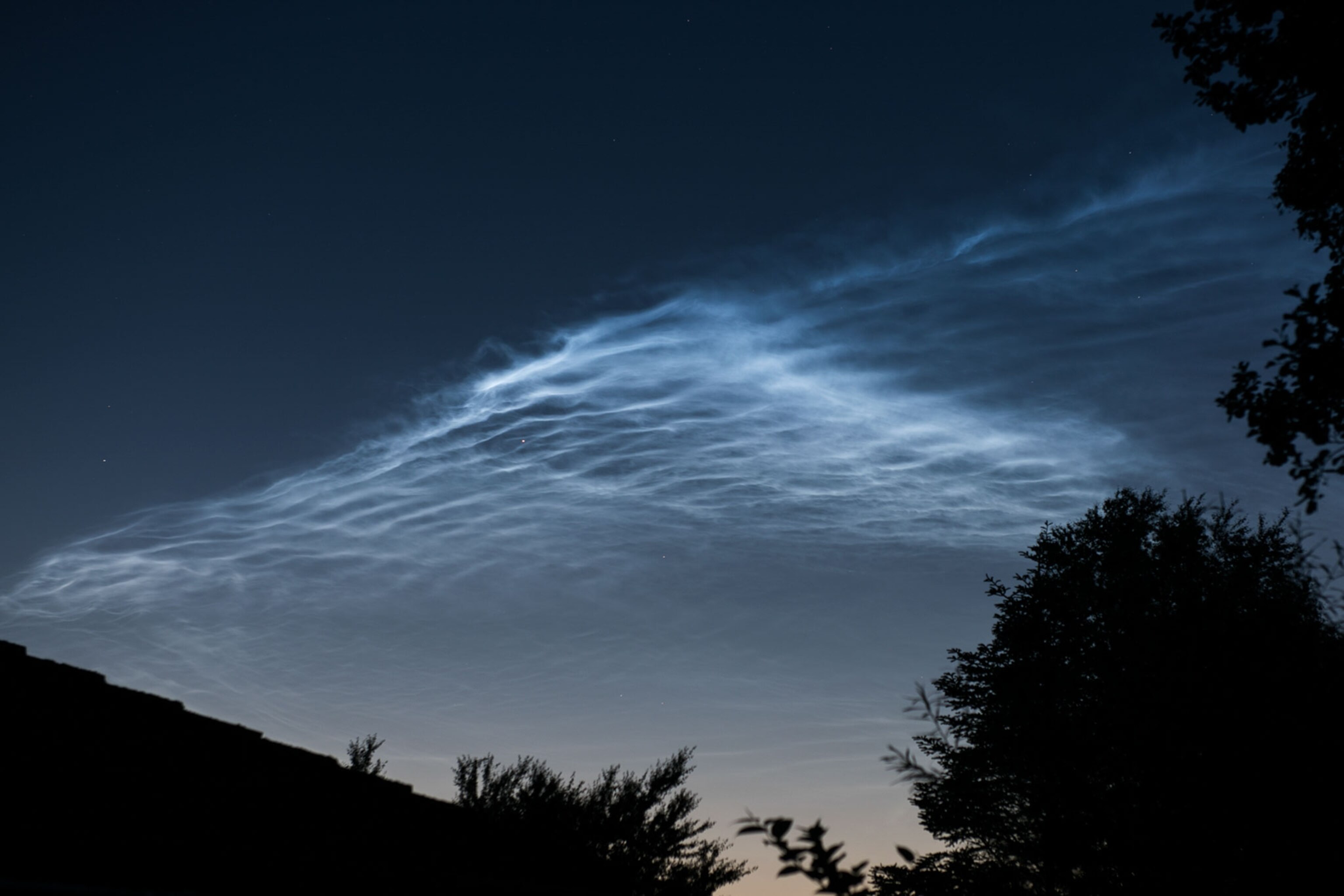






Eerie Clouds Glow at Night—How to See Them
An outburst of shining tendrils signals the start of viewing season for these high-flying clouds formed by space dust.
In recent weeks, sky-watchers have been reporting nightly outbursts of eerie tendrils glowing in the twilight skies.
The hypnotic displays signal the start of viewing season for noctilucent, or night-shining, clouds. The eye-catching wisps show up every year around local summer. In the Northern Hemisphere, sky-watchers can catch a glimpse of them painting the skies from now through August. Viewers in the Southern Hemisphere, meanwhile, should look for the clouds from November to February.
These mysterious, thin veils of clouds appear to form around the polar regions in the mesosphere, the highest level of Earth’s atmosphere. At these extreme heights, temperatures are a bone-chilling -148°F, and the air is a million times drier than any desert.
Under these conditions, water vapor freezes onto any dust particles floating in the region, forming ice crystals that congregate into tendrils and filaments. These thin clouds come to life around dusk and dawn, when the angle of sunlight makes them seem to glow against the darker twilight skies.
Noctilucent clouds were first recorded in 1885 after a volcanic eruption on the Indonesian island of Krakatoa, which sent a massive ash cloud into the upper atmosphere that circled Earth for months. Spectacular red sunsets and the distinctive glowing clouds persisted for years.
While such large volcanic eruptions are not all that frequent, nearly a hundred tons of meteoritic dust fall on Earth every day, and this debris seeds the formation of the noctilucent clouds we see in summer.
Southward Spread
To catch this elusive sky show, it’s important that your local northwestern sky is devoid of the more common lower-altitude clouds and that the background sky is sufficiently dark. Time your viewing for about an hour after local sunset, when the sun should about 10 degrees below the horizon.
In past years, the displays have traditionally ramped up after the June solstice, becoming noticeably brighter, more frequent, and covering larger areas of the deep twilight skies. This year is no exception, with reports of jaw-dropping displays already coming in from Scotland, Poland, and Russia.
People living in high latitude areas (between 45º and 70º above or below the Equator) have the best chance of seeing noctilucent clouds. However, over the last century, these unusual clouds have been spotted more frequently and much farther south, in places such as Kansas, Utah, and Colorado.
While it's a mystery why the clouds appear to be spreading, some scientists have suggested a link to climate change.
The gossamer clouds are even visible from space—astronauts on board the International Space Station have reported seeing them and have captured the occasional image.
Similar clouds were also spotted on Mars back in 2006, when the Mars Express orbiter saw them floating some 60 miles above the red planet’s surface. However, the Martian clouds are likely formed by frozen carbon dioxide.
Clear skies!
Andrew Fazekas, the Night Sky Guy, is the author of Star Trek: The Official Guide to Our Universe and host of NG Live! Mankind to Mars presentations. Follow him on Twitter, Facebook, and his website.
Related Topics
You May Also Like
Go Further
Animals
- Orangutan seen using plants to heal wound for first timeOrangutan seen using plants to heal wound for first time
- What La Palma's 'lava tubes' tell us about life on other planetsWhat La Palma's 'lava tubes' tell us about life on other planets
- This fungus turns cicadas into zombies who procreate—then dieThis fungus turns cicadas into zombies who procreate—then die
- How can we protect grizzlies from their biggest threat—trains?How can we protect grizzlies from their biggest threat—trains?
Environment
- What La Palma's 'lava tubes' tell us about life on other planetsWhat La Palma's 'lava tubes' tell us about life on other planets
- How fungi form ‘fairy rings’ and inspire superstitionsHow fungi form ‘fairy rings’ and inspire superstitions
- Your favorite foods may not taste the same in the future. Here's why.Your favorite foods may not taste the same in the future. Here's why.
- Are the Great Lakes the key to solving America’s emissions conundrum?Are the Great Lakes the key to solving America’s emissions conundrum?
- The world’s historic sites face climate change. Can Petra lead the way?The world’s historic sites face climate change. Can Petra lead the way?
History & Culture
- A short history of the Met Gala and its iconic looksA short history of the Met Gala and its iconic looks
- Meet the ruthless king who unified the Kingdom of Hawai'iMeet the ruthless king who unified the Kingdom of Hawai'i
- Hawaii's Lei Day is about so much more than flowersHawaii's Lei Day is about so much more than flowers
- When treasure hunters find artifacts, who gets to keep them?When treasure hunters find artifacts, who gets to keep them?
Science
- Why ovaries are so crucial to women’s health and longevityWhy ovaries are so crucial to women’s health and longevity
- Orangutan seen using plants to heal wound for first timeOrangutan seen using plants to heal wound for first time
Travel
- Why this unlikely UK destination should be on your radarWhy this unlikely UK destination should be on your radar
- A slow journey around the islands of southern VietnamA slow journey around the islands of southern Vietnam
- Is it possible to climb Mount Everest responsibly?Is it possible to climb Mount Everest responsibly?




